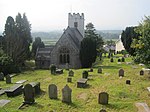Ffynnon Beuno and Cae Gwyn Caves

Ffynnon Beuno and Cae Gwyn Caves are two Scheduled Ancient Monuments, in Denbighshire, Wales, which are also designated a Site of Special Scientific Interest (SSSI). The site has two caves, with entrances close to each other high on a valley side, above the Vale of Clwyd. They were first excavated in 1883–5. Human tools have been found on the site dating back to around 36,000 BC, and a mammoth bone has been dated back to 16,000 BC. These very early discoveries were significant in providing one of the first direct associations between stone tools of paleolithic people and the bones of extinct pre-iceage animals such as mammoth and woolly rhinoceros.In 1963 it was designated as an SSSI for the palaeontological interest described above and for its species interest as a winter roost of lesser horseshoe bat.
Excerpt from the Wikipedia article Ffynnon Beuno and Cae Gwyn Caves (License: CC BY-SA 3.0, Authors, Images).Ffynnon Beuno and Cae Gwyn Caves
B5429,
Geographical coordinates (GPS) Address Nearby Places Show on map
Geographical coordinates (GPS)
| Latitude | Longitude |
|---|---|
| N 53.241 ° | E -3.3719 ° |
Address
Ffynnon Beuno Cave
B5429
LL16 4EN , Tremeirchion
Wales, United Kingdom
Open on Google Maps









